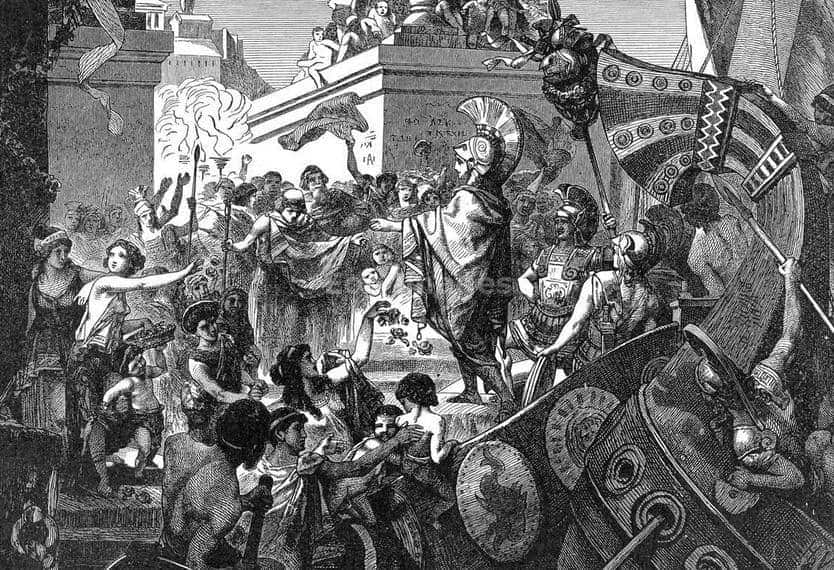The Second Peloponnesian War was fought between the city-states of Sparta and Athens in the 5th century BC. The conflict began in 431 BC and ended with utter defeat for Athens in 404 BC as its naval empire was destroyed. The First Peloponnesian War took place from 460-446 BC and was mainly comprised of skirmishes between Athens and Corinth; Sparta occasionally entered the fray against the Athenians.
Sparta and Athens were culturally very different places which led to disharmony and mistrust between them long before the Peloponnesian Wars. They joined with other Greek states to repel the Persian invasion but Sparta ultimately withdrew from this alliance and went back to its usual isolationist stance. After the Persian wars, the Greek states combined in a series of protective agreements. Athens founded the Delian League in 478-77 BC, but it soon became little more than an Athenian Empire. It angered the other city-states by moving the Delian League’s treasury to Athens in 454 BC.
The Peloponnesian League was formed in 505 BC, and members agreed to have the same allies and enemies as Sparta. The First Peloponnesian War concluded with the defeat of Athens at Koroneia in 446 BC. A treaty known as the Thirty Years Peace was signed between Sparta and Athens, but it lasted just 15 years. Despite losing in the first conflict, Athens was building its empire; a fact that worried Sparta. In 433 BC, Athens sided with Corcyra against Corinth and the following year; it laid siege to the city of Poteidaia. Athens then placed a trade embargo on Sparta’s ally Megara and finally, another Spartan ally, Thebes, attacked an Athenian ally, Plataea. Sparta invaded Attica in 431 BC and the Second Peloponnesian War was underway.

Athens Takes Control
The war can be divided into separate sections; the first spell of war lasted for a decade and was followed by six years of peace before hostilities came to a climax. The first couple of years went poorly for Athens as Sparta began the campaign by causing as much destruction to Athenian land as possible. A terrible plague hit Athens in 430 BC; it was so bad that Sparta decided against attacking its enemy in case its soldiers contracted the deadly illness. Things got worse for Athens when Pericles, one of its most influential leaders, died from the plague.
However, Athens recovered well and under the leadership of Nikias and Kleon, it enjoyed success in the Corinthian Gulf in 429 BC. The Peloponnesians began their Siege of Plataia in the same year. The city was an Athenian ally and the siege probably ended any lingering hope of peace between Athens and Sparta. The Thebans began the assault and succeeded in taking the city after two years.
The Spartans probably thought an early victory was possible, but these hopes were completely dashed as the tide of the war turned against them. Athens enjoyed a couple of significant wins in consecutive years. At the Battle of Olpae in 426 BC, over 1,000 Spartans died. Things looked bleak for Sparta in 425 BC after losing the Battle of Pylos and the Battle of Sphacteria in quick succession.
It was a crucial period of the war; Athens had the initiative, and there was the possibility of Sparta suing for peace. Spartans were always trained to die in battle rather than surrender, but at Sphacteria, 120 Spartans were captured. Athens looked to push home its advantage, and in 424 BC, it launched an expedition against Boeotia and Megara. However, this mission was a complete failure as it suffered a major defeat at the Battle of Delium. Athens lost over 1,000 men in a battle that cost it considerable momentum even though it did take Kythera, a Spartan island.
A one-year truce was called in 423 BC, but as soon as it expired, Kleon led an Athenian army to Thrace. His attempt to capture Amphipolis was a disaster as he died in the battle. The Spartan hero of Delium, Brasidas, was also killed in the fight. With two warlike leaders now dead, it became easier to create a peace treaty. In 421 BC, the Peace of Nicias was agreed. The deal agreed to restore the situation as it stood at the beginning of the war; Sparta was allowed keep Plataea and Athens held Nicaea.

